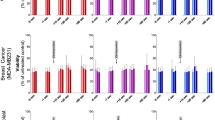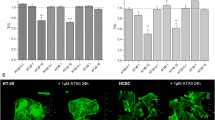Abstract
We examined the role of membrane fluidity and dynamics as important early events in the carcinogenic transformation of colonic epithelial cells. 1,2-Dimethylhydrazine dihydrochloride (DMH) was used to induce initial stages of colon cancer and diclofenac was used for chemoprevention. To determine alterations of membrane fluidity of rat colonic epithelial cells, fluidity (inverse of fluorescence polarization) and order parameter were studied with 1,6-diphenylhexatriene (DPH) polarization. Order parameter as well as fluorescence polarization was found to be significantly decreased, thus demonstrating an increase in the fluidity of the membrane. To further confirm the fluidity changes, microviscosity of the cell membrane was studied using pyrene excimer formation, which showed a significant decrease in microviscosity and hence elevated membrane fluidity (translational diffusion). The colonocytes were stained with merocyanine 540 (MC540) to further elaborate the changes in membrane fluidity and lipid packing. The increased number of colonocytes showing high MC540 fluorescence pointed towards the wide spaces and hence, high fluidity in the membrane after DMH treatment. Membrane dynamics studies, i.e., lipid phase separation and membrane phase state were carried out using N-NBD-PE and Laurdan, respectively. We saw a transition from the gel to a more liquid crystalline state of the membrane in the Laurdan experiment. Further more percentage quenching (%Q) value of N-NBD-PE showed less phase separation (or domain formation). Diclofenac co-administration with DMH was successful in reverting the changes observed, confirming the role of these anti-inflammatory drugs in considerable lipid affinity and consequently in the chemoprevention of early stages of colon cancer.





Similar content being viewed by others
References
Raghuraman H, Kelkar D, Chattopadhyay A (2003) Novel insights into membrane protein structure and dynamics utilizing the wavelength-selective fluorescence approach. Proc Indian Natl Sci Acad 69A(1):25–35
Arora A, Raghuraman H, Chattopadhyay A (2004) Influence of cholesterol and ergosterol on membrane dynamics: a fluorescence approach. Biochem Biophys Res Commun 318(4):920–926
McLaughlin S, Wang J, Gambhir A, Murray D (2002) PIP(2) and proteins: interactions, organization, and information flow. Annu Rev Biophys Biomol Struct 31:151–175
German JB, Dillard CJ, Whelan J (1995) Symposium: biological effects of dietary arachidonic acid. J Nutr 126:1076S–1080S
Vigdahl RL, Tukey RH (1977) Mechanism of action of novel anti-inflammatory drugs diflumidone and R-805. Biochem Pharmacol 26:307–311
Ricchi P, Zarrilli R, Palma AD, Acquaviva AM (2003) Nonsteroidal anti-inflammatory drugs in colorectal cancer: from prevention to therapy. Br J Cancer 88:803–807
Kaur J, Sanyal SN (2010) Oxidative stress and stress-signaling in chemoprevention of early colon cancer by diclofenac. Am J Biomed Sci 2(1):63–78
Kaur J, Sanyal SN (2009) Association of PI3-kinase and Wnt signaling in non-steroidal anti-inflammatory drug-induced apoptosis in experimental colon cancer. Am J Biomed Sci 1(4):395–405
Kaur J, Sanyal SN (2009b) Induction of apoptosis as a potential chemopreventive effect of dual cyclooxygenase inhibitor, diclofenac in early colon carcinogenesis. J Env Pathol Toxicol Oncol (in press)
Lucio M, Ferreiara H, Lima JLFC, Matos C, de-Castro B, Reis S (2004) Influence of some anti-inflammatory drugs in membrane fluidity studied by fluorescence anisotropy measurements. Phys Chem Chem Phys 6:1493–1498
Wiseman H, Cannon M, Arnstein HR, Barlow DJ (1992) The structural mimicry of membrane sterols by tamoxifen: evidence from cholesterol coefficients and molecular-modeling for its action as a membrane anti-oxidant and an anticancer agent. Biochim Biophys Acta 1138:197–202
Kanwar SS, Vaiphei K, Nehru B, Sanyal SN (2008) Antioxidative effects of non-steroidal anti-inflammatory drugs during the initiation stages of experimental colon carcinogenesis in rats. J Environ Pathol Toxicol Oncol 27(2):89–100
Mouille B, Robert V, Blachier F (2004) Adaptive increase of ornithine production and decrease of ammonia metabolism in rat colonocytes and hyperproteic diet ingestion. Am J Physiol Gastrointest Liver Physiol 287:G344–G351
Roediger WE, Truelove SC (1979) Method of preparing isolated colonic epithelial cells (colonocytes) for metabolic studies. Gut 20:484–488
Shinitzky M, Barenholz Y (1974) Dynamics of the hydrocarbon layer in liposomes of lecithin and sphingomyelin containing dicetylphosphate. J Biol Chem 249:2652–2657
Pottel H, Van der Meer W, Herreman W (1983) Correlation between the order parameter and the steady state fluorescence anisotropy of 1,6 diphenyl-1,3,5-hexatriene and an evaluation of membrane fluidity. Biochim Biophys Acta 730:181–186
Massey V, Williums CH Jr (1965) On the reaction mechanism of yeast glutathione reductase. J Biol Chem 240:4470–4475
Vanderkooi JM, Callis JB (1974) Pyrene. A probe of lateral diffusion in the hydrophobic region of membranes. Biochemistry 13(19):4000–4006
Baumber J, Meyers SA (2006) Changes in membrane lipid order with capacitation in rhesus macaque (Macaca mulatta) spermatozoa. J Androl 27(4):578–587
Nichols JW, Pagano RE (1981) Kinetics of soluble lipid monomer diffusion between vesicles. Biochemistry 20:2783–2789
Hoekstra D (1982) Fluorescence method for measuring the kinetics of Ca2+-induced phase separations in phophatidylserine-containing lipid vesicles. Biochemistry 21:1055–1061
Parasassi T, DeStasio G, d’Ubaldo A, Gratton E (1990) Phase fluctuation in phospholipid membranes revealed by Laurdan fluorescence. Biophys J 57:1179–1186
Ambrosini A, Zolese G, Wozniak M, Genga D, Boscaro M, Mantero F, Balerica G (2003) Idiopathic infertility: susceptibility of spermatozoa to in vitro capacitation, in the presence and the absence of palmitylethanolamide (a homologue of anandamide), is strongly correlated with membrane polarity studies by Laurdan fluorescence. Mol Hum Reprod 9:381–388
Parasassi T, DeStasio G, Ravagnan G, Rusch RM, Gratton E (1991) Quantitation of lipid phases in phospholipid vesicles by the generalized polarization of Laurdan fluorescence. Biophys J 60:179–180
Parasassi T, Ravagnan G, Rusch RM, Gratton E (1993) Modulation and dynamics of phase properties in phopholipid mixtures detected by Laurdan fluorescence. Photochem Photobiol 57:403–410
Baritaki S, Apostolakis S, Kanellou P, Dimanche-Boitrel MT, Spandidos DA, Bonavida B (2007) Reversal of tumor resistance to apoptotic stimuli by alteration of membrane fluidity: therapeutic implications. Adv Cancer Res 98:149–190
Schachter D, Shinitzky M (1977) Fluorescence polarization studies of rat intestinal microvillus membranes. J Clin Invest 59:536–548
Fuchs P, Parola P, Robbins W, Blout ER (1975) Fluorescence polarizations and viscosities of membrane lipids of 3T3 cells. Proc Natl Acad Sci USA 72:3351–3354
Galla M, Sackmann E (1974) Lateral diffusion in the hydrophobic region of membranes: use of pyrene excimers as optical probes. Biochim Biophys Acta 339(1):103–115
Brigati C, Noonan DM, Albini A, Benelli R (2002) Tumors and inflammatory infiltrates: friends and foes? Clin Exp Metastasis 19(3):247–258
McEvoy L, Schlegel RA, Williamson P, Del Buono BJ (1998) Merocyanine 540 as a flow cytometric probe of membrane lipid organization in leukocytes. J Leukoc Biol 44:337–344
Chen JY, Mak NK, Leung WN, Chen SC, Leung KN, Cheung NH (1997) A study of the binding of merocyanine 540 to myeloid leukemia M1 cells using an intensified charge-coupled device for fluorescence imaging microscopy. J Photochem Photobiol 39:49–55
Yu H, Hui S (1992) Merocyanine 540 as a probe to monitor molecular packing of phosphatidylcholine: a monolayer epifluorescence microscopy and spectroscopy study. Biochim Biophys Acta 1107:245–254
Lagerberg JW, Kallen KJ, Haest CW, VanSteveninck J, Dubbelman TM (1995) Factors affecting the amount and the mode of Merocyanine 540 binding to the membrane of human erythrocytes. A comparison with the binding to leukemia cells. Biochim Biophys Acta 1235:428–436
Gaffney DK, Feix JB, Schwarz HP, Struve MF, Sieber F (1991) Cholesterol content but not plasma membrane fluidity influences the susceptibility of L1210 leukemia cells to merocyanine 540-sensitized irradiation. Photochem Photobiol 54:717–723
Onganer Y, Quitevis EL (1994) Dynamics of merocyanine 540 in model biomembranes: photoisomerization studies in small unilamellar vesicles. Biochim Biophys Acta 1192:27–34
Mower DA Jr, Peckham DW, Illera VA, Fishbaugh JK, Stunz LL, Ashman RF (1994) Decreased membrane phospholipid packing and decreased cell size precede DNA cleavage in mature mouse B cell apoptosis. J Immunol 152:4832–4842
Kanwar SS, Vaiphei K, Nehru B, Sanyal SN (2007) Chemopreventive effects of non-steroidal anti-inflammatory drugs in the membrane lipid composition and fluidity parameters of the 1,2-dimethylhydrazine-induced colon carcinogenesis in rats. Drug Chem Toxicol 30:293–309
Kusumi A, Nakada C, Ritchie K, Murase K, Suzuki K, Murakoshi H, Kasai RS, Kondo J, Fujiwara T (2005) Paradigm shift of the plasma membrane concept from the two-dimensional continuum fluid to the partitioned fluid: high-speed single-molecule tracking of membrane molecules. Annu Rev Biophys Biomol Struct 34:351–378
Chong PL-G (1990) Interactions of Laurdan and PRODAN with membranes at high pressure. High Press Res 5:761–763
Parasassi T, Conti F, Gratton E (1986) Time-resolved fluorescence emission spectra of Laurdan in phospholipid vesicles by multifrequency phase and modulation fluorometry. Cell Mol Biol 32:103–108
Parasassi T, Di Stefano M, Loiero M, Ravagnan G, Gratton E (1994) Influence of cholesterol on phospholipid bilayers phase domains as detected by Laurdan fluorescence. Biophys J 66:120–132
Brasitus TA, Dudeja PK, Dahiya R (1986) Premalignant alterations in the lipid composition and fluidity of colonic brush border membranes of rats administered 1,2-dimethylhydrazine. J Clin Invest 77:831–840
Kanwar SS, Roy KR, Nehru B, Reddanna P, Sanyal SN (2009) Na+-stimulated Na+/H+ exchange and an unfavorable Ca2+ homeostasis initiate the cycloxygenase-2 inhibitors-induced apoptotic signals in colonic epithelial cells during the early stage of colon carcinogenesis. Oncol Res 18:1–15
Garcia-Martin ML, Herigault G, Remy C, Farion R, Ballesteros P, Coles JA, Cerdan S, Ziegler A (2001) Mapping extracellular pH in rat brain gliomas in vivo by 1H magnetic resonance spectroscopic imaging: comparison with maps of metabolites. Cancer Res 61:6524–6531
Acknowledgment
Financial assistance from the Council of Scientific and Industrial Research (CSIR), Government of India (37(1308)/07/EMR-II) is gratefully acknowledged.
Author information
Authors and Affiliations
Corresponding author
Rights and permissions
About this article
Cite this article
Kaur, J., Sanyal, S.N. Alterations in membrane fluidity and dynamics in experimental colon cancer and its chemoprevention by diclofenac. Mol Cell Biochem 341, 99–108 (2010). https://doi.org/10.1007/s11010-010-0441-6
Received:
Accepted:
Published:
Issue Date:
DOI: https://doi.org/10.1007/s11010-010-0441-6




